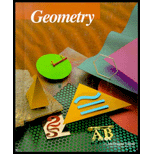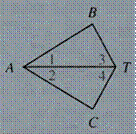
McDougal Littell Jurgensen Geometry: Student Edition Geometry
5th Edition
ISBN: 9780395977279
Author: Ray C. Jurgensen, Richard G. Brown, John W. Jurgensen
Publisher: Houghton Mifflin Company College Division
expand_more
expand_more
format_list_bulleted
Question
Chapter 6, Problem 16CR
To determine
To complete: the given statement using
Expert Solution & Answer
Answer to Problem 16CR
Explanation of Solution
Given information:
The given figure is as follows:

The given statement is “
Concept used:
The
The angle opposite to
The angle opposite to
Consider
Hence,
Chapter 6 Solutions
McDougal Littell Jurgensen Geometry: Student Edition Geometry
Ch. 6.1 - Prob. 1CECh. 6.1 - Prob. 2CECh. 6.1 - Prob. 3CECh. 6.1 - Prob. 4CECh. 6.1 - Prob. 5CECh. 6.1 - Prob. 6CECh. 6.1 - Prob. 7CECh. 6.1 - Prob. 8CECh. 6.1 - Prob. 9CECh. 6.1 - Prob. 10CE
Ch. 6.1 - Prob. 11CECh. 6.1 - Prob. 12CECh. 6.1 - Prob. 13CECh. 6.1 - Prob. 14CECh. 6.1 - Prob. 15CECh. 6.1 - Prob. 16CECh. 6.1 - Prob. 17CECh. 6.1 - Prob. 18CECh. 6.1 - Prob. 19CECh. 6.1 - Prob. 20CECh. 6.1 - Prob. 1WECh. 6.1 - Prob. 2WECh. 6.1 - Prob. 3WECh. 6.1 - Prob. 4WECh. 6.1 - Prob. 5WECh. 6.1 - Prob. 6WECh. 6.1 - Prob. 7WECh. 6.1 - Prob. 8WECh. 6.1 - Prob. 9WECh. 6.1 - Prob. 10WECh. 6.1 - Prob. 11WECh. 6.1 - Prob. 12WECh. 6.1 - Prob. 13WECh. 6.2 - Prob. 1CECh. 6.2 - Prob. 2CECh. 6.2 - Prob. 3CECh. 6.2 - Prob. 4CECh. 6.2 - Prob. 5CECh. 6.2 - Prob. 6CECh. 6.2 - Prob. 7CECh. 6.2 - Prob. 8CECh. 6.2 - Prob. 9CECh. 6.2 - Prob. 10CECh. 6.2 - Prob. 11CECh. 6.2 - Prob. 12CECh. 6.2 - Prob. 1WECh. 6.2 - Prob. 2WECh. 6.2 - Prob. 3WECh. 6.2 - Prob. 4WECh. 6.2 - Prob. 5WECh. 6.2 - Prob. 6WECh. 6.2 - Prob. 7WECh. 6.2 - Prob. 8WECh. 6.2 - Prob. 9WECh. 6.2 - Prob. 10WECh. 6.2 - Prob. 11WECh. 6.2 - Prob. 12WECh. 6.2 - Prob. 13WECh. 6.2 - Prob. 14WECh. 6.2 - Prob. 15WECh. 6.2 - Prob. 16WECh. 6.2 - Prob. 17WECh. 6.2 - Prob. 18WECh. 6.2 - Prob. 19WECh. 6.2 - Prob. 20WECh. 6.2 - Prob. 21WECh. 6.2 - Prob. 22WECh. 6.2 - Prob. 1MRECh. 6.2 - Prob. 2MRECh. 6.2 - Prob. 3MRECh. 6.2 - Prob. 4MRECh. 6.2 - Prob. 5MRECh. 6.2 - Prob. 6MRECh. 6.2 - Prob. 7MRECh. 6.2 - Prob. 8MRECh. 6.2 - Prob. 9MRECh. 6.3 - Prob. 1CECh. 6.3 - Prob. 2CECh. 6.3 - Prob. 3CECh. 6.3 - Prob. 4CECh. 6.3 - Prob. 5CECh. 6.3 - Prob. 6CECh. 6.3 - Prob. 7CECh. 6.3 - Prob. 8CECh. 6.3 - Prob. 9CECh. 6.3 - Prob. 10CECh. 6.3 - Prob. 1WECh. 6.3 - Prob. 2WECh. 6.3 - Prob. 3WECh. 6.3 - Prob. 4WECh. 6.3 - Prob. 5WECh. 6.3 - Prob. 6WECh. 6.3 - Prob. 7WECh. 6.3 - Prob. 8WECh. 6.3 - Prob. 9WECh. 6.3 - Prob. 10WECh. 6.3 - Prob. 11WECh. 6.3 - Prob. 12WECh. 6.3 - Prob. 13WECh. 6.3 - Prob. 14WECh. 6.3 - Prob. 15WECh. 6.3 - Prob. 16WECh. 6.3 - Prob. 17WECh. 6.3 - Prob. 18WECh. 6.3 - Prob. 19WECh. 6.3 - Prob. 20WECh. 6.3 - Prob. 1ST1Ch. 6.3 - Prob. 2ST1Ch. 6.3 - Prob. 3ST1Ch. 6.3 - Prob. 4ST1Ch. 6.3 - Prob. 5ST1Ch. 6.3 - Prob. 6ST1Ch. 6.3 - Prob. 7ST1Ch. 6.3 - Prob. 8ST1Ch. 6.3 - Prob. 9ST1Ch. 6.3 - Prob. 10ST1Ch. 6.4 - Prob. 1CECh. 6.4 - Prob. 2CECh. 6.4 - Prob. 3CECh. 6.4 - Prob. 4CECh. 6.4 - Prob. 5CECh. 6.4 - Prob. 6CECh. 6.4 - Prob. 7CECh. 6.4 - Prob. 8CECh. 6.4 - Prob. 9CECh. 6.4 - Prob. 10CECh. 6.4 - Prob. 11CECh. 6.4 - Prob. 12CECh. 6.4 - Prob. 13CECh. 6.4 - Prob. 14CECh. 6.4 - Prob. 15CECh. 6.4 - Prob. 16CECh. 6.4 - Prob. 17CECh. 6.4 - Prob. 18CECh. 6.4 - Prob. 19CECh. 6.4 - Prob. 20CECh. 6.4 - Prob. 1WECh. 6.4 - Prob. 2WECh. 6.4 - Prob. 3WECh. 6.4 - Prob. 4WECh. 6.4 - Prob. 5WECh. 6.4 - Prob. 6WECh. 6.4 - Prob. 7WECh. 6.4 - Prob. 8WECh. 6.4 - Prob. 9WECh. 6.4 - Prob. 10WECh. 6.4 - Prob. 11WECh. 6.4 - Prob. 12WECh. 6.4 - Prob. 13WECh. 6.4 - Prob. 14WECh. 6.4 - Prob. 15WECh. 6.4 - Prob. 16WECh. 6.4 - Prob. 17WECh. 6.4 - Prob. 18WECh. 6.4 - Prob. 19WECh. 6.4 - Prob. 20WECh. 6.4 - Prob. 21WECh. 6.4 - Prob. 22WECh. 6.4 - Prob. 23WECh. 6.4 - Prob. 24WECh. 6.4 - Prob. 1AECh. 6.4 - Prob. 2AECh. 6.4 - Prob. 1BECh. 6.4 - Prob. 2BECh. 6.4 - Prob. 3BECh. 6.5 - Prob. 1CECh. 6.5 - Prob. 2CECh. 6.5 - Prob. 3CECh. 6.5 - Prob. 4CECh. 6.5 - Prob. 5CECh. 6.5 - Prob. 6CECh. 6.5 - Prob. 7CECh. 6.5 - Prob. 8CECh. 6.5 - Prob. 9CECh. 6.5 - Prob. 10CECh. 6.5 - Prob. 1WECh. 6.5 - Prob. 2WECh. 6.5 - Prob. 3WECh. 6.5 - Prob. 4WECh. 6.5 - Prob. 5WECh. 6.5 - Prob. 6WECh. 6.5 - Prob. 7WECh. 6.5 - Prob. 8WECh. 6.5 - Prob. 9WECh. 6.5 - Prob. 10WECh. 6.5 - Prob. 11WECh. 6.5 - Prob. 12WECh. 6.5 - Prob. 13WECh. 6.5 - Prob. 14WECh. 6.5 - Prob. 15WECh. 6.5 - Prob. 1ST2Ch. 6.5 - Prob. 2ST2Ch. 6.5 - Prob. 3ST2Ch. 6.5 - Prob. 4ST2Ch. 6.5 - Prob. 5ST2Ch. 6.5 - Prob. 6ST2Ch. 6.5 - Prob. 7ST2Ch. 6.5 - Prob. 8ST2Ch. 6.5 - Prob. 9ST2Ch. 6 - Prob. 1CRCh. 6 - Prob. 2CRCh. 6 - Prob. 3CRCh. 6 - Prob. 4CRCh. 6 - Prob. 5CRCh. 6 - Prob. 6CRCh. 6 - Prob. 7CRCh. 6 - Prob. 8CRCh. 6 - Prob. 9CRCh. 6 - Prob. 10CRCh. 6 - Prob. 11CRCh. 6 - Prob. 12CRCh. 6 - Prob. 13CRCh. 6 - Prob. 14CRCh. 6 - Prob. 15CRCh. 6 - Prob. 16CRCh. 6 - Prob. 17CRCh. 6 - Prob. 18CRCh. 6 - Prob. 1CTCh. 6 - Prob. 2CTCh. 6 - Prob. 3CTCh. 6 - Prob. 4CTCh. 6 - Prob. 5CTCh. 6 - Prob. 6CTCh. 6 - Prob. 7CTCh. 6 - Prob. 8CTCh. 6 - Prob. 9CTCh. 6 - Prob. 10CTCh. 6 - Prob. 11CTCh. 6 - Prob. 12CTCh. 6 - Prob. 13CTCh. 6 - Prob. 14CTCh. 6 - Prob. 15CTCh. 6 - Prob. 16CTCh. 6 - Prob. 1ARCh. 6 - Prob. 2ARCh. 6 - Prob. 3ARCh. 6 - Prob. 4ARCh. 6 - Prob. 5ARCh. 6 - Prob. 6ARCh. 6 - Prob. 7ARCh. 6 - Prob. 8ARCh. 6 - Prob. 9ARCh. 6 - Prob. 10ARCh. 6 - Prob. 11ARCh. 6 - Prob. 12ARCh. 6 - Prob. 13ARCh. 6 - Prob. 14ARCh. 6 - Prob. 15ARCh. 6 - Prob. 16ARCh. 6 - Prob. 17ARCh. 6 - Prob. 18ARCh. 6 - Prob. 19ARCh. 6 - Prob. 1CURCh. 6 - Prob. 2CURCh. 6 - Prob. 3CURCh. 6 - Prob. 4CURCh. 6 - Prob. 5CURCh. 6 - Prob. 6CURCh. 6 - Prob. 7CURCh. 6 - Prob. 8CURCh. 6 - Prob. 9CURCh. 6 - Prob. 10CURCh. 6 - Prob. 11CUR
Additional Math Textbook Solutions
Find more solutions based on key concepts
Houses A real estate agent claims that all things being equal, houses with swimming pools tend to sell for less...
Introductory Statistics
What is the domain and the range of y=secx ?
Precalculus
For what value of a is
continuous at every x?
University Calculus: Early Transcendentals (4th Edition)
Two fair dice are rolled. What is the conditional probability that at least one lands on 6 given that the dice ...
A First Course in Probability (10th Edition)
Moving shadow A 5-foot-tall woman walks at 8 ft/s toward a streetlight that is 20 ft above the ground. What is ...
Calculus: Early Transcendentals (2nd Edition)
Fill in each blank so that the resulting statement is true. If n is a counting number, bn, read ______, indicat...
College Algebra (7th Edition)
Knowledge Booster
Learn more about
Need a deep-dive on the concept behind this application? Look no further. Learn more about this topic, geometry and related others by exploring similar questions and additional content below.Similar questions
- Can someone help me with this please?arrow_forwardMariela is in her classroom and looking out of a window at a tree, which is 20 feet away. Mariela’s line of sight to the top of the tree creates a 42° angle of elevation, and her line of sight to the base of the tree creates a 31° angle of depression. What is the height of the tree, rounded to the nearest foot? Be sure to show your work to explain how you got your answer.arrow_forward1arrow_forward
arrow_back_ios
SEE MORE QUESTIONS
arrow_forward_ios
Recommended textbooks for you
 Elementary Geometry For College Students, 7eGeometryISBN:9781337614085Author:Alexander, Daniel C.; Koeberlein, Geralyn M.Publisher:Cengage,
Elementary Geometry For College Students, 7eGeometryISBN:9781337614085Author:Alexander, Daniel C.; Koeberlein, Geralyn M.Publisher:Cengage, Elementary Geometry for College StudentsGeometryISBN:9781285195698Author:Daniel C. Alexander, Geralyn M. KoeberleinPublisher:Cengage Learning
Elementary Geometry for College StudentsGeometryISBN:9781285195698Author:Daniel C. Alexander, Geralyn M. KoeberleinPublisher:Cengage Learning

Elementary Geometry For College Students, 7e
Geometry
ISBN:9781337614085
Author:Alexander, Daniel C.; Koeberlein, Geralyn M.
Publisher:Cengage,

Elementary Geometry for College Students
Geometry
ISBN:9781285195698
Author:Daniel C. Alexander, Geralyn M. Koeberlein
Publisher:Cengage Learning
Orthogonality in Inner Product Spaces; Author: Study Force;https://www.youtube.com/watch?v=RzIx_rRo9m0;License: Standard YouTube License, CC-BY
Abstract Algebra: The definition of a Group; Author: Socratica;https://www.youtube.com/watch?v=QudbrUcVPxk;License: Standard Youtube License